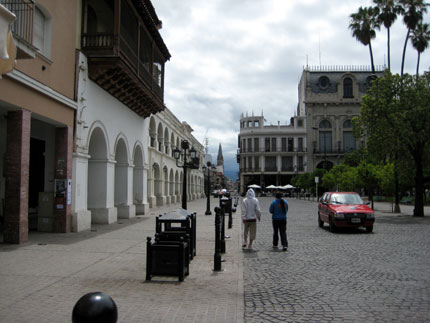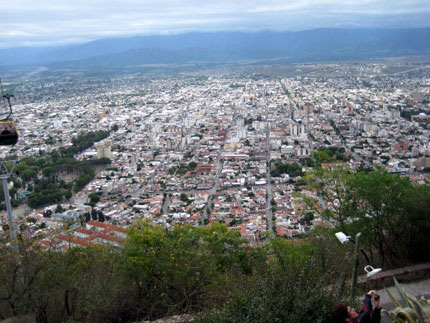I’m starting in the middle of our journey to Argentina this time, about a new area we visited. I wrote quite a bit of about the City of Buenos Aires on our last trip to Argentina in January, February, 2008.
We arrived in Buenos Aires on November 8,2008 and our trip out of town was on November 15 to the northwest of Argentina, bordered by Bolivia to the north and Chile to the west. We arrived in the city of Salta by overnight bus. The bus we took was luxurious with seats that flatten into a bed with blankets and pillows. Provided on these buses are a snack, dinner with wine, an after dinner drink, and breakfast in the morning.
Salta is both a province and a city. The providence of Salta has an extraordinary range of landscape from puma (high desert) populated only by llamas and a few other creatures, to the cloud forest and from hill sides of pink rock where cactus thrive, to valleys irrigated by the Incas of the past to produce scarlet fields of red peppers. The irrigation system developed by the Incas are still in use.

The City of Salta is at the heart of this province in the broad Lerma Valley with a background of dark green hills. Salta was founded in 1582 and became a strong hold for the Spanish which conquered the native and Inca population.

There is an active night life and the architectural is from the colonial period. Things are much cheaper here than Buenos Aires. We spent the first few days walking to the multiple museums which contain much of the history of the area. We took a tour of the city but learned much more of the city by just going out on our own, which seems to be the case in most city bus tours that we have taken.
One of the things that we liked the most was a gondola ride to a top of a mountain to a place called Cerro San Bernardino from which you can see most of the city. The cost was ten pesos (about $3 US) and is well worth the ride. One of the nicest museums was the Museo Antropologico which contains relics from the pre-hispanic cultures of the area. It was at one time considered by the natives that to have a flatten head front and back was a sign of higher intelligence. So in order to achieve that, they tied boards to the front and back of their heads to flatten the the skull as the children grew. Several of those skulls are on display along with a well preserved mummy.
By the way, people drive here like there is no tomorrow. Cars come to intersections and it seems like whoever gets there first wins. As in most parts of Argentina, stop signs are suggestions to slow down, double yellow lines means you can pass anytime you want or to drive in either lane. Pedestrians are someone to avoid hitting but not stopping for.
John O’Dell